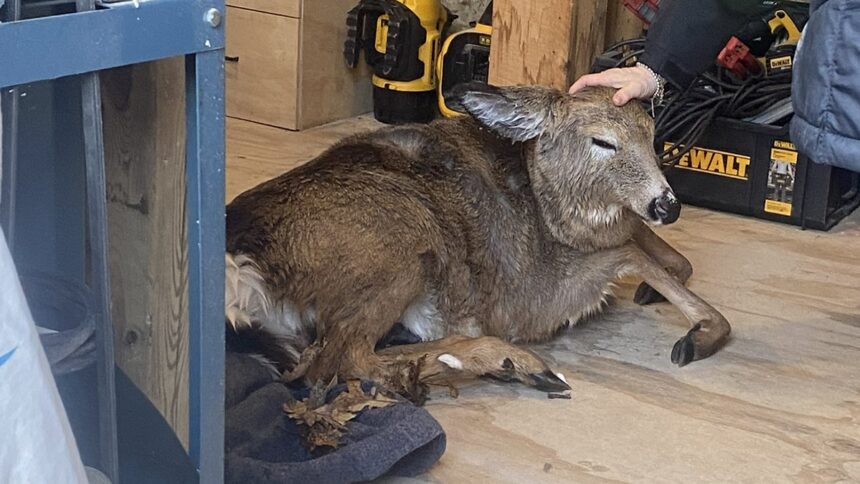The damp June morning couldn’t dampen the spirits of volunteers unloading crates of specialized feed at the Ottawa Wildlife Centre. What would normally be a routine delivery became something extraordinary – the largest single donation of wildlife food in the centre’s 36-year history.
“This changes everything for us,” explained Donna DuBreuil, president of the Ottawa-Carleton Wildlife Centre, as she supervised the arrival of nearly 2,000 kilograms of specialized feed. “We’re seeing record numbers of orphaned wildlife this season, particularly squirrels and raccoons displaced by urban development.”
The donation comes at a critical time. Environment Canada data shows this spring has been particularly challenging for wildlife, with unseasonably heavy rainfall contributing to habitat destruction and increasing human-wildlife conflicts across the Ottawa Valley. The city’s rapid expansion into previously undeveloped areas has further complicated the situation.
Local construction company Taggart Homes provided the donation after one of their development sites uncovered a family of raccoons during excavation. Rather than simply relocating the animals, company president Jeff Parkes initiated a broader response.
“We understand our responsibility to the communities we build in extends beyond human residents,” Parkes told me while helping unload supplies. “Wildlife rehabilitation centres operate largely on donations, and the incredible work they do deserves our support.”
The statistics are sobering. The Ottawa Wildlife Centre reports a 32% increase in animal intakes compared to last year, with more than 400 orphaned or injured animals currently under their care. Similar patterns have emerged at rehabilitation centres across eastern Ontario.
City councillor Riley Brockington, who represents River Ward, attended the donation event and highlighted the municipal government’s evolving approach to urban wildlife.
“For years, wildlife management was an afterthought in urban planning,” Brockington admitted. “Today’s donation reflects a growing awareness that we share this city with many species. Our new Urban Wildlife Strategy acknowledges this reality.”
The specialized feed donation includes custom formulas developed by wildlife nutritionists that mimic natural diets for different species and developmental stages. For baby raccoons, this means a precise mix of proteins and fats that would normally come from their mother’s milk. For recovering birds of prey, it includes calcium-enriched meat products that support bone healing.
“People don’t realize how specific these diets need to be,” explained Dr. Sarah Fortin, the centre’s veterinarian. “Feeding inappropriate foods can cause developmental problems or even death. Commercial pet foods simply won’t do.”
At a nearby table, volunteer coordinator Michelle Hanna demonstrated the feeding process for a weeks-old squirrel. The tiny creature, eyes still closed, eagerly accepted formula from a syringe smaller than my pinky finger.
“Each orphaned baby needs feeding every few hours,” Hanna explained. “With this donation, we can focus our fundraising efforts on medical supplies and facility improvements instead of constantly worrying about food.”
The donation’s timing coincides with what wildlife experts call “baby season” – the spring and early summer months when most wildlife species give birth. This natural cycle often collides with human activities like construction, tree removal, and increased outdoor recreation.
Statistics from the Ministry of Natural Resources and Forestry indicate that human-wildlife interactions typically spike by 45% during this period. Many of these encounters result in orphaned animals when frightened parents abandon their young or are injured or killed.
The centre’s education coordinator, Alison Brant, sees the donation as an opportunity to increase public awareness about coexisting with urban wildlife.
“Most people want to help when they find injured or orphaned animals, but don’t know how,” Brant said. “Sometimes the best help is leaving animals alone or calling experts before intervening.”
Indeed, a 2024 survey by Nature Canada found that while 78% of Canadians express concern for urban wildlife, only 23% know the proper steps to take when encountering animals in distress. This knowledge gap can lead to well-intentioned but harmful human interventions.
For the wildlife centre’s staff, today’s donation represents more than just food security. It symbolizes a growing community recognition of their work’s importance.
Longtime volunteer Marjorie Hinds, who has witnessed the centre’s growth over two decades, couldn’t hide her emotion. “When I started, we operated out of a garage. Today we have corporate donors and city officials acknowledging our value. That’s progress.”
As I watched a young raccoon cautiously explore her temporary enclosure, her injured paw carefully wrapped, the real impact of the donation became clear. Each bag of specialized feed represents another chance for these animals to return to the wild.
The Ottawa Wildlife Centre expects to release over 60% of their current patients back to suitable habitats later this summer. That success rate, impressive by any standard, may improve with the nutrition security this donation provides.
City resident Priya Sharma stopped by the centre with her two children to witness the donation. “We found an injured chickadee in our backyard last month and brought it here,” she told me. “The kids were amazed by the care it received. Now they’re wildlife champions.”
Such transformational experiences highlight the centres’ dual role as both rehabilitation facilities and community educators. Each animal interaction becomes an opportunity to foster greater environmental stewardship.
As the last of the donation was stored away, DuBreuil reflected on what comes next. “This incredible gift gives us breathing room, but wildlife rehabilitation needs sustained support. We hope this inspires others to contribute, whether through donations, volunteering, or simply being more mindful of their impact on urban wildlife.”
For the raccoons, squirrels, birds, and other creatures currently receiving care, such philosophical considerations matter little. Their immediate needs – food, shelter, and medical attention – are what count. Thanks to today’s record donation, those needs will be met, one carefully measured meal at a time.






